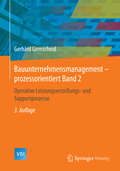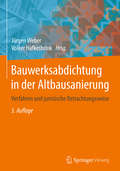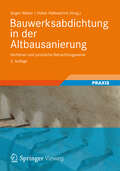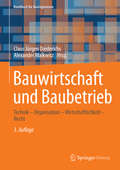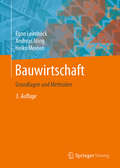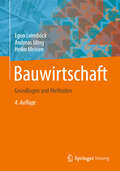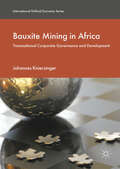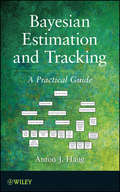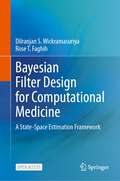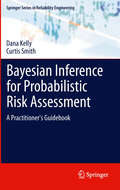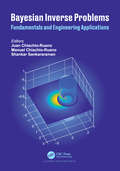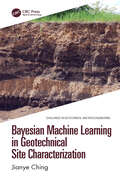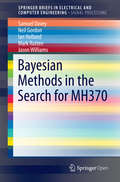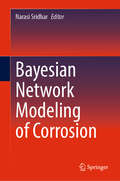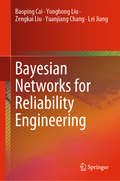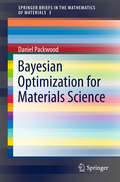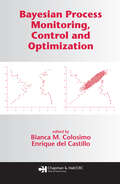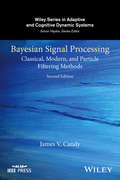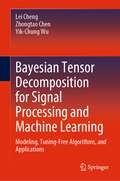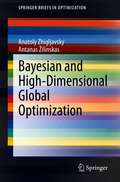- Table View
- List View
Bauunternehmensmanagement-prozessorientiert Band 1: Operative Leistungserstellungs- und Supportprozesse (VDI-Buch)
by Gerhard GirmscheidStrategische und operative Unternehmensprozesse bilden den Schl#65533;ssel f#65533;r notwendige lebenszyklusorientierte Ver#65533;nderungen in der Baubranche. Im Band 1 - Strategische Managementprozesse - werden die wichtigsten Methoden zur erfolgreichen Ausrichtung von Gesch#65533;ftseinheiten und Unternehmen sowie alle wichtigen Teilprozesse zur Unternehmensgestaltung und -f#65533;hrung ausf#65533;hrlich dargestellt. Strategie-, Marketing- und Organisationsplanung f#65533;r neue und bestehende Gesch#65533;ftsfelder und deren operative Umsetzung stehen im Mittelpunkt. Sie finden Handlungsempfehlungen f#65533;r die systematische Durchf#65533;hrung ihrer strategischen Aufgaben und die zukunftsorientierte Strukturierung der Unternehmensprozesse. Gr#65533;#65533;ere Unternehmen k#65533;nnen mit diesem Wissen ihre Positionierung im aggressiven, dynamischen und komplexen Umfeld verbessern und die eigene Wettbewerbsposition st#65533;rken. Kleinere wachstumsorientierte Betriebe finden darin die Methodik, die sie ihrem Unternehmensaufbau zugrunde legen sollten. Moderne Managementkonzepte werden auf die Bauwirtschaft abgebildet.
Bauwerksabdichtung in der Altbausanierung: Verfahren und juristische Betrachtungsweise
by Jürgen Weber Clemens Hecht Ulrich Kühne Ulrich Steinert Uwe Wild Volker Hafkesbrink Rainer Spirgatis Martin Mossau Peter Neundorf Virginie Schulz Hardy Dinse Christoph HellkötterDas Buch stellt die umfangreichen Möglichkeiten nachträglicher Abdichtungen im erdberührten und nicht erdberührten Bereich beim Bauen im Bestand vor. Ziel ist die Darstellung der wichtigsten Technologien und verwendbaren Materialien. Das Autorenteam beschreibt die Wirkprinzipien einzelner Verfahren ebenso wie die Höhe und Art von Risiken gewählter Abdichtungsweisen.Die 5. Auflage wurde überarbeitet und den Regeln der Technik angepasst. Wo es notwendig ist, wird auf die neue DIN 18531 bis 18535 eingegangen. Ergänzend dazu gibt es jetzt die vollständigen WTA Merkblätter zur Injektion und mechanische Abdichtung. Die Autoren beraten den Leser zu allen rechtlichen "Fallstricken", die vom Bauleistungsangebot bis zur Bauabnahme auftreten können und setzen dabei keine juristische Vorbildung voraus. Der juristische Teil als ein wesentlicher Bestandteil des Buches u. a. wegen der Neuregelungen im Werkvertragsrecht des BGB zum 01.01.2009 im Zusammenhang mit dem Forderungssicherungsgesetz aktualisiert, sondern auch um neue Themen ergänzt. Unter anderem werden grob die Abläufe und Besonderheiten eines Bauprozesses dargestellt.
Bauwerksabdichtung in der Altbausanierung: Verfahren und juristische Betrachtungsweise
by Clemens Hecht Ulrich Steinert Uwe Wild Rainer Spirgatis Martin Mossau Peter Neundorf Hardy Dinse Christoph Hellkötter Virginie SchützDas Buch stellt die umfangreichen Möglichkeiten nachträglicher Abdichtungen im erdberührten und nicht erdberührten Bereich beim Bauen im Bestand vor. Ziel ist die Darstellung der wichtigsten Technologien und verwendbaren Materialien mit ihren Vor- und Nachteilen. Das Autorenteam beschreibt die Wirkprinzipien einzelner Verfahren ebenso wie die Höhe und Art von Risiken gewählter Abdichtungsweisen.Die 5. Auflage wurde teilweise erweitert und überarbeitet sowie den aktuellen Regeln der Technik angepasst. Ergänzend dazu gibt es jetzt die vollständigen WTA Merkblätter zur Injektion und mechanische Abdichtung.Die Autoren beraten den Leser zu allen rechtlichen "Fallstricken", die vom Bauleistungsangebot bis zur Bauabnahme auftreten können und setzen dabei keine juristische Vorbildung voraus. Der juristische Teil behandelt sämtliche rechtlichen Themen einschließlich der rechtlichen Regelungen für Bauverträge, die nach dem 01.01.2018 abgeschlossen wurden.
Bauwerksabdichtung in der Altbausanierung: Verfahren und juristische Betrachtungsweise
by Jürgen Weber Clemens Hecht Stefan Hemmann Ulrich Kühne Ulrich Steinert Uwe Wild Volker HafkesbrinkDas Buch stellt die umfangreichen Möglichkeiten nachträglicher Abdichtungen im erdberührten Bereich vor. Ziel ist die Darstellung der wichtigsten Technologien und verwendbaren Materialien. Das Autorenteam beschreibt die Wirkprinzipien einzelner Verfahren ebenso wie die Höhe und Art von Risiken gewählter Abdichtungsweisen. Mit diesem Werk finden auch die in Fachkreisen erheblich kontrovers diskutierten "elektrophysikalischen Verfahren" nach dem theoretischen Wirkungsprinzip Beachtung. Die Autoren beraten den Leser zu allen rechtlichen "Fallstricken", die vom Bauleistungsangebot bis zur Bauabnahme auftreten können und setzen dabei keine juristische Vorbildung voraus.
Bauwerksdynamik und Erschütterungsmessungen
by Armin ZieglerDas Buch gibt eine Einführung in die Dynamik-Probleme im Bauwesen. Dazu gehören Bauwerks- und Baugrund-Dynamik sowie Erschütterungsmessung. Weitere Schwerpunkte sind Erschütterungsausbreitung beim Schienenverkehr, Fußgängerbrücken und Kirchtürmen. Anhand von zahlreichen Beispielen aus der Praxis wird die Anwendung der Theorie gezeigt.
Bauwerksdynamik und Erschütterungsmessungen
by Armin Ziegler Daniel Gsell Marcel BirchmeierDas Buch gibt eine Einführung in die Dynamik-Probleme im Bauwesen. Dazu gehören Bauwerks- und Baugrund-Dynamik sowie Erschütterungsmessung. Weitere Schwerpunkte sind Erschütterungsausbreitung beim Schienenverkehr, Fußgängerbrücken und Kirchtürmen. Anhand von zahlreichen Beispielen aus der Praxis wird die Anwendung der Theorie gezeigt.
Bauwirtschaft und Baubetrieb: Technik – Organisation – Wirtschaftlichkeit – Recht (Handbuch für Bauingenieure)
by Alexander Malkwitz Claus Jürgen DiederichsDas in 3. Auflage erscheinende Standardwerk des Bauingenieurwesens bietet Grundwissen kompakt, vollständig und aktuell. Das Handbuch wurde den aktuellen Normen und Richtlinien sowie veränderten Zielen und Wertvorstellungen angepasst und versteht sich als Lehrbuch für Studierende und Nachschlagewerk für Praktiker. Es vermittelt Fach- und Methodenwissen über die Bauwirtschaft im Rahmen der volkswirtschaftlichen und betriebswirtschaftlichen Zusammenhänge, über die Unternehmensführung, die Projektentwicklung, das Immobilien- und Projektmanagement inkl. Nachtragsmanagement, über das Private Baurecht sowie den Baubetrieb und die Bauverfahrenstechnik.
Bauwirtschaft: Grundlagen und Methoden
by Egon Leimböck Andreas Iding Heiko MeinenAuch die 3. Auflage des Fachbuchs bildet Themen ab, die im Bau- und Bauhauptgewerbe in der Berufspraxis von Belang sind wie beispielsweise Organisation und Management, Preisfindung und Controlling. Dabei werden auch die Schnittstellen zu angrenzenden Branchen (Finanz- und Immobilienwirtschaft) in angemessenem Umfang aufgezeigt. Besondere Beachtung findet der Aspekt der Nachhaltigkeit im Kapitel "Nachhaltiges Wirtschaften im Bauunternehmen". im Bauunternehmen. Hauptzielgruppen sind sowohl Leserinnen und Leser aus der Praxis als auch Studierende der Hochschulen. Dem Praktiker soll ein schnelles Nachlesen von Themen erm#65533;glicht werden, um konkrete praktische Problemstellungen durch einen theoretischen Bezug besser l#65533;sen zu k#65533;nnen.
Bauwirtschaft: Grundlagen und Methoden
by Egon Leimböck Andreas Iding Heiko MeinenDas Fachbuch Bauwirtschaft gibt einen Überblick über alle bauwirtschaftlichen bzw. baubetriebswirtschaftlichen Themen, die im Bau- und Bauhauptgewerbe von Belang sind. Dazu gehört eine Einordnung in den volkswirtschaftlichen Kontext genauso wie ein Einblick in betriebswirtschaftliche Aspekte wie Organisation und Management, Preisfindung, Rechnungswesen, Controlling oder Marketing. Dabei werden auch die Schnittstellen zu angrenzenden Branchen (Finanz- und Immobilienwirtschaft) in angemessenem Umfang berücksichtigt. Besondere Beachtung findet der Aspekt der Nachhaltigkeit im Kapitel "Nachhaltiges Wirtschaften im Bauunternehmen", das vollständig überarbeitet und erweitert wurde. Zudem sieht sich die Bauwirtschaft der Notwendigkeit einer zunehmenden Digitalisierung gegenüber, um in Zeiten des Fachkräftemangels dringend nötige Produktivitätsreserven zu heben. Ein neues Kapitel widmet sich daher der Frage, wie und wo Digitalisierung sinnvoll eingesetzt werden kann. Besondersdem Praktiker soll ein schnelles Nachlesen von Themen ermöglicht werden, um konkrete Problemstellungen durch einen theoretischen Bezug besser lösen zu können. Studierenden dient dieses Buch als Grundlage bei der Vermittlung von Studieninhalten im Bereich der Betriebswirtschaft im Bauwesen.
Bauxite Mining in Africa: Transnational Corporate Governance and Development (International Political Economy Series)
by Johannes KnierzingerThis book deals with the consequences of the inclusion of African states and communities in the global aluminium chain. The so-called "New Scramble for Africa" of the 2000s illustrated how seriously African living conditions are affected by continuous cycles of boom and bust, and how strongly the quality of life currently depends on the investment decisions and corporate social responsibility policies of transnational corporations. Taking the example of the global production network of bauxite and aluminium, the author focuses on the socio-political aspects of this dependency, which he achieves through the conducting of a series of interviews with various involved parties.
Bay Area Iron Master Al Zampa: A Life Building Bridges
by John V. Robinson Isabelle MaynardAlfred Zampa didn't know what he was getting into when he took a construction job in 1925 on the Carquinez Bridge, one of the first to cross San Francisco Bay. Despite the risk, Zampa relished the challenge and embarked on an illustrious career that made him a local legend. His impressive feats of iron craft are evident in numerous spans, including the Bay Bridge and Golden Gate, as well as others across the country. He was one of the first to survive a fall from the Golden Gate Bridge, making him a founding member of the Halfway to Hell Club in 1936. The Alfred Zampa Memorial Bridge, named to honor the man after his death, replaced the first bridge he had worked on nearly eighty years earlier. This remarkable story of skill, grit and enduring spirit is told through oral histories collected by John Robinson and Isabelle Maynard.
Bay Bridge: History and Design of a New Icon
by Ira Nadel Donald MacdonaldAn innovative landmark a quarter century in the making, the new eastern span of the San Francisco-Oakland Bay Bridge represents the latest spectacular chapter in the history of this storied structure. The new bridge's architect, Donald MacDonald, teams up with author Ira Nadel to create this illuminating book. With friendly text and charming illustrations, Bay Bridge reveals the design decisions that have shaped the evolution of the bridge over the last century--from the history of the original bridge, through the planning of the new span, to the construction of its signature 525-foot-high white tower. In the same elegant package as Golden Gate Bridge and Alcatraz, this volume makes a lovely souvenir for San Francisco devotees, architecture buffs, and tourists.
Bayesian Estimation and Tracking: A Practical Guide
by Anton J. HaugA practical approach to estimating and tracking dynamic systems in real-worl applicationsMuch of the literature on performing estimation for non-Gaussian systems is short on practical methodology, while Gaussian methods often lack a cohesive derivation. Bayesian Estimation and Tracking addresses the gap in the field on both accounts, providing readers with a comprehensive overview of methods for estimating both linear and nonlinear dynamic systems driven by Gaussian and non-Gaussian noices.Featuring a unified approach to Bayesian estimation and tracking, the book emphasizes the derivation of all tracking algorithms within a Bayesian framework and describes effective numerical methods for evaluating density-weighted integrals, including linear and nonlinear Kalman filters for Gaussian-weighted integrals and particle filters for non-Gaussian cases. The author first emphasizes detailed derivations from first principles of eeach estimation method and goes on to use illustrative and detailed step-by-step instructions for each method that makes coding of the tracking filter simple and easy to understand.Case studies are employed to showcase applications of the discussed topics. In addition, the book supplies block diagrams for each algorithm, allowing readers to develop their own MATLAB® toolbox of estimation methods.Bayesian Estimation and Tracking is an excellent book for courses on estimation and tracking methods at the graduate level. The book also serves as a valuable reference for research scientists, mathematicians, and engineers seeking a deeper understanding of the topics.
Bayesian Filter Design for Computational Medicine: A State-Space Estimation Framework
by Dilranjan S. Wickramasuriya Rose T. FaghihThis book serves as a tutorial that explains how different state estimators (Bayesian filters) can be built when all or part of the observations are binary. The book begins by briefly motivating the need for point process state estimation followed by an introduction to the overall approach, as well as some basic background material in statistics that are necessary for the equation derivations that are utilized in subsequent chapters. The subsequent chapters focus on different state-space models and provide step-by-step explanations on how to build the corresponding Bayesian filters. Each of the main chapters that describes a single state-space model also describes the corresponding MATLAB code examples at the end. Descriptions are also provided regarding the code. The code contains both simulated and experimental data examples. All the experimental data examples are taken from real-world experiments. The experiments involve the recording of skin conductance, heartrate and blood cortisol data. A MATLAB toolbox of code examples that cover the different filters covered in the book is included in a companion webpage. The book is primarily intended for graduate students in either electrical engineering or biomedical engineering who will be beginning research in state estimation related to point process data or mixed data (i.e., point processes and other types of observations). The book can also be used by practicing researchers who measure skin conductance and heart rate or pulsatile hormones in their own work (e.g. in psychology). This is an open access book.
Bayesian Inference for Probabilistic Risk Assessment: A Practitioner's Guidebook (Springer Series in Reliability Engineering)
by Dana Kelly Curtis SmithBayesian Inference for Probabilistic Risk Assessment provides a Bayesian foundation for framing probabilistic problems and performing inference on these problems. Inference in the book employs a modern computational approach known as Markov chain Monte Carlo (MCMC). The MCMC approach may be implemented using custom-written routines or existing general purpose commercial or open-source software. This book uses an open-source program called OpenBUGS (commonly referred to as WinBUGS) to solve the inference problems that are described. A powerful feature of OpenBUGS is its automatic selection of an appropriate MCMC sampling scheme for a given problem. The authors provide analysis "building blocks" that can be modified, combined, or used as-is to solve a variety of challenging problems. The MCMC approach used is implemented via textual scripts similar to a macro-type programming language. Accompanying most scripts is a graphical Bayesian network illustrating the elements of the script and the overall inference problem being solved. Bayesian Inference for Probabilistic Risk Assessment also covers the important topics of MCMC convergence and Bayesian model checking. Bayesian Inference for Probabilistic Risk Assessment is aimed at scientists and engineers who perform or review risk analyses. It provides an analytical structure for combining data and information from various sources to generate estimates of the parameters of uncertainty distributions used in risk and reliability models.
Bayesian Inverse Problems: Fundamentals and Engineering Applications
by Juan Chiachío-RuanoThis book is devoted to a special class of engineering problems called Bayesian inverse problems. These problems comprise not only the probabilistic Bayesian formulation of engineering problems, but also the associated stochastic simulation methods needed to solve them. Through this book, the reader will learn how this class of methods can be useful to rigorously address a range of engineering problems where empirical data and fundamental knowledge come into play. The book is written for a non-expert audience and it is contributed to by many of the most renowned academic experts in this field.
Bayesian Machine Learning in Geotechnical Site Characterization (Challenges in Geotechnical and Rock Engineering)
by Jianye ChingBayesian data analysis and modelling linked with machine learning offers a new tool for handling geotechnical data. This book presents recent advancements made by the author in the area of probabilistic geotechnical site characterization.Two types of correlation play central roles in geotechnical site characterization: cross-correlation among soil properties and spatial-correlation in the underground space. The book starts with the introduction of Bayesian notion of probability “degree of belief”, showing that well-known probability axioms can be obtained by Boolean logic and the definition of plausibility function without the use of the notion “relative frequency”. It then reviews probability theories and useful probability models for cross-correlation and spatial correlation. Methods for Bayesian parameter estimation and prediction are also presented, and the use of these methods demonstrated with geotechnical site characterization examples.Bayesian Machine Learning in Geotechnical Site Characterization suits consulting engineers and graduate students in the area.
Bayesian Methods in the Search for MH370 (SpringerBriefs in Electrical and Computer Engineering)
by Neil Gordon Jason Williams Sam Davey Ian Holland Mark RuttenThis book demonstrates how nonlinear/non-Gaussian Bayesian time series estimation methods were used to produce a probability distribution of potential MH370 flight paths. It provides details of how the probabilistic models of aircraft flight dynamics, satellite communication system measurements, environmental effects and radar data were constructed and calibrated. The probability distribution was used to define the search zone in the southern Indian Ocean.The book describes particle-filter based numerical calculation of the aircraft flight-path probability distribution and validates the method using data from several of the involved aircraft’s previous flights. Finally it is shown how the Reunion Island flaperon debris find affects the search probability distribution.
Bayesian Network Modeling of Corrosion
by Narasi SridharThis book represents a compilation of experience from a slate of experts involved in developing and deploying Bayesian Networks (BN) for corrosion management. The contributors describe how probability distributions can be developed for corroding systems and BN can be applied as an ideal framework to deal with corrosion risk. Corrosion can develop suddenly and grow rapidly after a long incubation period and take many non-uniform aspects, including pitting and stress corrosion cracking, that cannot be mitigated by simply bulking up the system. They also describe how complex engineering structures and systems are influenced by many natural and engineering factors that come together in myriad ways. It provides a broad perspective to the reader on the potential of BN as an artificial intelligence tool for corrosion risk management and the challenges for implementing it.
Bayesian Networks for Reliability Engineering
by Lei Jiang Baoping Cai Yonghong Liu Zengkai Liu Yuanjiang ChangThis book presents a bibliographical review of the use of Bayesian networks in reliability over the last decade. Bayesian network (BN) is considered to be one of the most powerful models in probabilistic knowledge representation and inference, and it is increasingly used in the field of reliability. After focusing on the engineering systems, the book subsequently discusses twelve important issues in the BN-based reliability methodologies, such as BN structure modeling, BN parameter modeling, BN inference, validation, and verification. As such, it is a valuable resource for researchers and practitioners in the field of reliability engineering.
Bayesian Optimization for Materials Science (SpringerBriefs in the Mathematics of Materials #3)
by Daniel PackwoodThis book provides a short and concise introduction to Bayesian optimization specifically for experimental and computational materials scientists. After explaining the basic idea behind Bayesian optimization and some applications to materials science in Chapter 1, the mathematical theory of Bayesian optimization is outlined in Chapter 2. Finally, Chapter 3 discusses an application of Bayesian optimization to a complicated structure optimization problem in computational surface science. Bayesian optimization is a promising global optimization technique that originates in the field of machine learning and is starting to gain attention in materials science. For the purpose of materials design, Bayesian optimization can be used to predict new materials with novel properties without extensive screening of candidate materials. For the purpose of computational materials science, Bayesian optimization can be incorporated into first-principles calculations to perform efficient, global structure optimizations. While research in these directions has been reported in high-profile journals, until now there has been no textbook aimed specifically at materials scientists who wish to incorporate Bayesian optimization into their own research. This book will be accessible to researchers and students in materials science who have a basic background in calculus and linear algebra.
Bayesian Process Monitoring, Control and Optimization
by Bianca M. Colosimo Enrique Del CastilloAlthough there are many Bayesian statistical books that focus on biostatistics and economics, there are few that address the problems faced by engineers. Bayesian Process Monitoring, Control and Optimization resolves this need, showing you how to oversee, adjust, and optimize industrial processes.Bridging the gap between application and dev
Bayesian Signal Processing: Classical, Modern, and Particle Filtering Methods
by James V. CandyPresents the Bayesian approach to statistical signal processing for a variety of useful model sets This book aims to give readers a unified Bayesian treatment starting from the basics (Baye's rule) to the more advanced (Monte Carlo sampling), evolving to the next-generation model-based techniques (sequential Monte Carlo sampling). This next edition incorporates a new chapter on "Sequential Bayesian Detection," a new section on "Ensemble Kalman Filters" as well as an expansion of Case Studies that detail Bayesian solutions for a variety of applications. These studies illustrate Bayesian approaches to real-world problems incorporating detailed particle filter designs, adaptive particle filters and sequential Bayesian detectors. In addition to these major developments a variety of sections are expanded to "fill-in-the gaps" of the first edition. Here metrics for particle filter (PF) designs with emphasis on classical "sanity testing" lead to ensemble techniques as a basic requirement for performance analysis. The expansion of information theory metrics and their application to PF designs is fully developed and applied. These expansions of the book have been updated to provide a more cohesive discussion of Bayesian processing with examples and applications enabling the comprehension of alternative approaches to solving estimation/detection problems. The second edition of Bayesian Signal Processing features: "Classical" Kalman filtering for linear, linearized, and nonlinear systems; "modern" unscented and ensemble Kalman filters: and the "next-generation" Bayesian particle filters Sequential Bayesian detection techniques incorporating model-based schemes for a variety of real-world problems Practical Bayesian processor designs including comprehensive methods of performance analysis ranging from simple sanity testing and ensemble techniques to sophisticated information metrics New case studies on adaptive particle filtering and sequential Bayesian detection are covered detailing more Bayesian approaches to applied problem solving MATLAB® notes at the end of each chapter help readers solve complex problems using readily available software commands and point out other software packages available Problem sets included to test readers' knowledge and help them put their new skills into practice Bayesian Signal Processing, Second Edition is written for all students, scientists, and engineers who investigate and apply signal processing to their everyday problems.
Bayesian Tensor Decomposition for Signal Processing and Machine Learning: Modeling, Tuning-Free Algorithms, and Applications
by Lei Cheng Zhongtao Chen Yik-Chung WuThis book presents recent advances of Bayesian inference in structured tensor decompositions. It explains how Bayesian modeling and inference lead to tuning-free tensor decomposition algorithms, which achieve state-of-the-art performances in many applications, includingblind source separation;social network mining;image and video processing;array signal processing; and,wireless communications.The book begins with an introduction to the general topics of tensors and Bayesian theories. It then discusses probabilistic models of various structured tensor decompositions and their inference algorithms, with applications tailored for each tensor decomposition presented in the corresponding chapters. The book concludes by looking to the future, and areas where this research can be further developed.Bayesian Tensor Decomposition for Signal Processing and Machine Learning is suitable for postgraduates and researchers with interests in tensor data analytics and Bayesian methods.
Bayesian and High-Dimensional Global Optimization (SpringerBriefs in Optimization)
by Anatoly Zhigljavsky Antanas ŽilinskasAccessible to a variety of readers, this book is of interest to specialists, graduate students and researchers in mathematics, optimization, computer science, operations research, management science, engineering and other applied areas interested in solving optimization problems. Basic principles, potential and boundaries of applicability of stochastic global optimization techniques are examined in this book. A variety of issues that face specialists in global optimization are explored, such as multidimensional spaces which are frequently ignored by researchers. The importance of precise interpretation of the mathematical results in assessments of optimization methods is demonstrated through examples of convergence in probability of random search. Methodological issues concerning construction and applicability of stochastic global optimization methods are discussed, including the one-step optimal average improvement method based on a statistical model of the objective function. A significant portion of this book is devoted to an analysis of high-dimensional global optimization problems and the so-called ‘curse of dimensionality’. An examination of the three different classes of high-dimensional optimization problems, the geometry of high-dimensional balls and cubes, very slow convergence of global random search algorithms in large-dimensional problems , and poor uniformity of the uniformly distributed sequences of points are included in this book.
